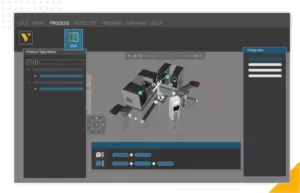There are many misconceptions about purchasing workflow simulation software: cost, learning curve, compatibility or functionality that already exists in other products. Find out why they are not true and why such software can be useful to you.
Proper planning – before selecting, purchasing and integrating production simulation solutions – is the most critical activity that users can control to ensure a successful outcome.

The integration of new technologies does not always go as planned, and the same goes for the integration of workflow simulation solutions.
We have several examples of companies that have achieved smooth and rapid implementations, and were able to see immediate results by integrating production simulation into their workflows . But, there are also examples of companies that have not had such positive experiences. This could be due to several reasons, and it's certainly not always the customer's fault.
We have generally noted that adequate planning – before selecting, purchasing and integrating production simulation solutions – is the most critical activity that users can control to ensure a successful outcome .
Insufficient or incorrect planning can lead to all sorts of problems during onboarding, as one would expect.
Over the years, we have noticed that many problems caused by lack of planning have become widespread as problems with production simulation solutions. We've heard most of them and can tell you that many of these issues are explained out of context. So, to help set the record straight, we're going to address some of the most commonly cited concerns here.
1- Production flow simulation software has a high initial cost
It's too expensive!
There are a variety of production simulation solutions on the market to choose from, each with their own strengths and weaknesses.
Although many of these platforms and solutions share similarities, their features, applications and prices may vary.
Purchasing an enterprise software solution is an investment and should be approached with the same diligence and discipline that you would apply to most other major purchases . It's helpful to first define your needs and requirements and then compare your options to them.
We find that most companies do not need the "Cadillac package" for their applications , and that they can acquire a production simulation solution that meets their needs and requirements for a much more reasonable price than what They thought it would cost .
2- Production flow simulation software has a high cost of ownership
There are high hidden costs
Many factors can determine the total cost of ownership of a production simulation solution.
Our solutions are compatible with resources readily available to most design and manufacturing planning teams, so the main cost drivers are licensing, maintenance and support.
When budgeting for a new simulation solution, you should consider the period of time you plan to use the software, as well as the services and resources you will need to start, operate and maintain it during this period .
With licensing, you need to consider whether it makes sense to purchase a perpetual license or have an annual usage right. It is also important to consider the value and importance of maintenance and support services .
3 - production flow simulation software requires a lot of customization
It takes too long to set up
Production simulation software is powerful and many platforms are capable of quite advanced applications.
Most production simulation products have basic solutions that they have created that work more or less “out of the box”.
Depending on your application, you may want to further customize your solution by creating your own components, customizing your interface, or defining new workflows.
This work can usually be defined and scoped with the help of your software vendor so you can decide whether this is something you want to do in-house or outsource. The majority of companies we have worked with fall into this category of minimal customization. They did their due diligence and decided that our platform and solutions best met their needs and requirements, so we could build a solution for them with minimal customization.
There is another category of companies that have a very specialized need for simulation or require greater customization. They may require additional development work to customize existing solutions or prefer to create entirely new features and solutions. Companies that fall into this category typically either have a very niche application or are looking for a platform on which to develop white label solutions. We have worked with several companies on these types of custom projects over the years, but the majority of our clients fall into the first category.
4 - Industrial simulation software is too complex
It requires solid mechanical knowledge to use it
Solid mechanical knowledge is certainly an asset for professionals working in the manufacturing environment.
Manufacturing is, after all, a highly mechanized and increasingly complex industry.
However, not all tools used by manufacturing professionals require a specialized degree to operate them .
We can confidently make this statement regarding our production simulation solutions. We developed solutions specifically for design and manufacturing planning teams, and designed them for use by technical and non-technical professionals.
You don't need to have an engineering degree or extensive domain knowledge to perform many routine tasks with our software , such as setting up layouts or presenting simulations.
Common sense and a little practice are usually all that is needed to get you started.
5 - Flow simulation software requires a long learning curve
We will have to invest a lot of time and money to learn how to use it
As with learning any new skill, learning to become proficient with a new production simulation solution will require some investment in training and education.
The learning curve varies from solution to solution and depends on the level of detail you want to achieve.
For most of our standard applications, the learning curve is quite short . Indeed, we have created clear and simple workflows that guide users through the most common use cases.
There are also many web resources, such as guides and videos , to help new and experienced users become familiar with our solutions.
Whatever your application, it is important to determine in advance the skills and training required for your users to become proficient and comfortable with their new tools .
6. It will not be compatible with my CAD files
I will need to purchase and learn new CAD software in order to import my designs into that software
Software compatibility is always an issue when integrating new software solutions or even updating existing products.
This is difficult to manage and can be a huge source of friction in getting organizations to adopt new solutions.
For our market, one of the biggest compatibility issues is with CAD.
Most manufacturing simulation solutions use CAD to define the geometry of new components; however, not all simulation products are compatible with the most common CAD formats out of the box.
Some software companies offer plug-ins that allow their solutions to import CAD files from different formats, while others mandate the use of a specific format.
Companies that use simulation solutions that are not compatible with their CAD software are forced to purchase and adopt new CAD software or seek a CAD conversion solution.
Fortunately, there are production simulation solutions that include compatibility features in their offering.
By supporting CAD file types from most major CAD vendors, they allow geometry to be imported natively into simulation, saving time and reducing hassle. This is the case with Visual Components workflow simulation software .
7. Other software can do the same thing
I can do the same things using spreadsheets and charts
Changing your staff's habits and convincing them to adopt new technologies and solutions, and new ways of working, can be difficult.
The challenge is even greater when we believe that the systems in place are good enough.
Traditional manufacturing design and planning tools, such as spreadsheets and CAD, may have been sufficient in the past, but the increasingly complex and competitive nature of today's manufacturing environment makes it impossible to trust only them.
We've heard several stories about how system integrators and manufacturers have made costly and avoidable mistakes that would have been easily detected with production simulation.
Companies involved in manufacturing design and planning are being told that the status quo is not good enough to compete in today's manufacturing environment.
Conclusion: Production flow simulation software can be affordable and have a quick return on investment
When considering purchasing new production simulation software, it helps to make a plan. It's an investment, and you should approach this decision-making process with the same diligence and discipline that you would apply to any other major purchase. Consider your needs and requirements, compare the available options that meet them, and plan how you will implement the solution.
While such a purchase may seem like a significant cost for the company (financial, human effort), it is above all an investment that will allow you to quickly optimize your industrial performance .
Purchasing new production simulation software can be a difficult process for many people, but we are here to help. Do not hesitate to ask us your questions and we will be happy to advise you!




